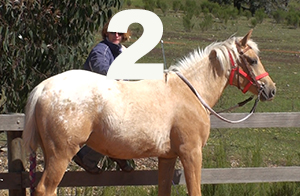
2 - Hips to the Fence - Summary
This video gives you an overview of the of the hips to the fence lesson steps.
Training Notes:
- This lesson is wonderful because not only is it terribly practical, teaching the horse to move his hips to the mounting block and stand still while you mount, but it also provides an excellent example of how to control your horse's emotional level.
- It is a very simple lesson and I think we often over-complicate things for ourselves - and, as a result, for our horses.
- Remember, all you are trying to do is teach the horse to move his left foot to the left when you signal him to do so - simple!
- It is a great lesson to teach early on (as soon as the horse has done Give to the Bit) because it helps us as trainers to recognise when to release the pressure and to break our lessons down into their smallest possible steps.
- Have fun with the lesson and remember to praise the horse often - he will come out of this short lesson felling like a super star if you do (and so will you!).
Lesson Steps:
- Have the horse in a bridle with the reins over his head.
- Hold the left rein in your left hand, quite close to the bit (3-6 inches from the bit).
- Place the horse on the fence so that his right side is next to the fence and you are standing close to his head.
- Cue the horse to move by gently tapping him on the hindquarter (slightly lower than the area you used to teach 'go forward' when teaching Give to the Bit so as not to confuse the horse).
- Watch the horse's hindquarter and as soon as he moves his left foot left, release the pressure but taking the whip away.
- If you think your horse is finding it difficult, try to look for any movement of the hindquarter to the left and reward that. The horse might move the right foot away from the fence and you should release on that.
- The first couple of steps are the hardest but the horse quickly establishes the release of pressure with moving his left foot to the left and things move quickly from there.
- Be careful not to pull your horse's head to the left. If you are going to do anything, other than signal your horse to keep his shoulder still, move the horse's head to the right. Moving the head to the right will make it easier to move the hips to the left (just like disengaging the hindquarters - move the head right and the hindquarters move left).
- As the horse begins to associate the cue with moving his hips, ask for more steps to the left.
- It may be necessary to raise the emotional level a bit here - ask more quickly to get more forward motion and the horse is likely to keep moving left and therefore get further around.
- You must decide when the horse knows the lesson well enough to cue him again when his hips are not aligned with the fence. If he has moved a few steps from the fence and stopped, and then you ask him again, he may move his hips to the right. If this happens he has not yet associated the pressure cue with moving his hips left and you will need to go back to aligning him on the fence again so that he doesn't make that mistake too many times.
- If he does make that mistake a lot then you will also be rewarding him for moving his hips right and he will become confused and possibly frustrated. We want to keep it simple and easy for the horse.
- Once the horse has the connection of the whip (or clicking fingers) associated with moving his hops left then you can move his shoulders to the left, using the rein and walking backwards down the fence.
- This will give you side-pass and also free the horse up as some horses feel 'blocked' when they are prevented from moving forwards in this way.
- Side-pass is good to get the horse thinking 'forward' again.
- As the horse progresses, you can climb up on the fence.
- This is a little more difficult as the cue from the fence is different so give the horse a chance to learn this new cue and remember to release and praise him when he does.
- As the horse is standing quietly by the fence it is a wonderful time to praise him and let him rest - remember, this is exactly what you want: a horse that stands quietly to be mounted.
